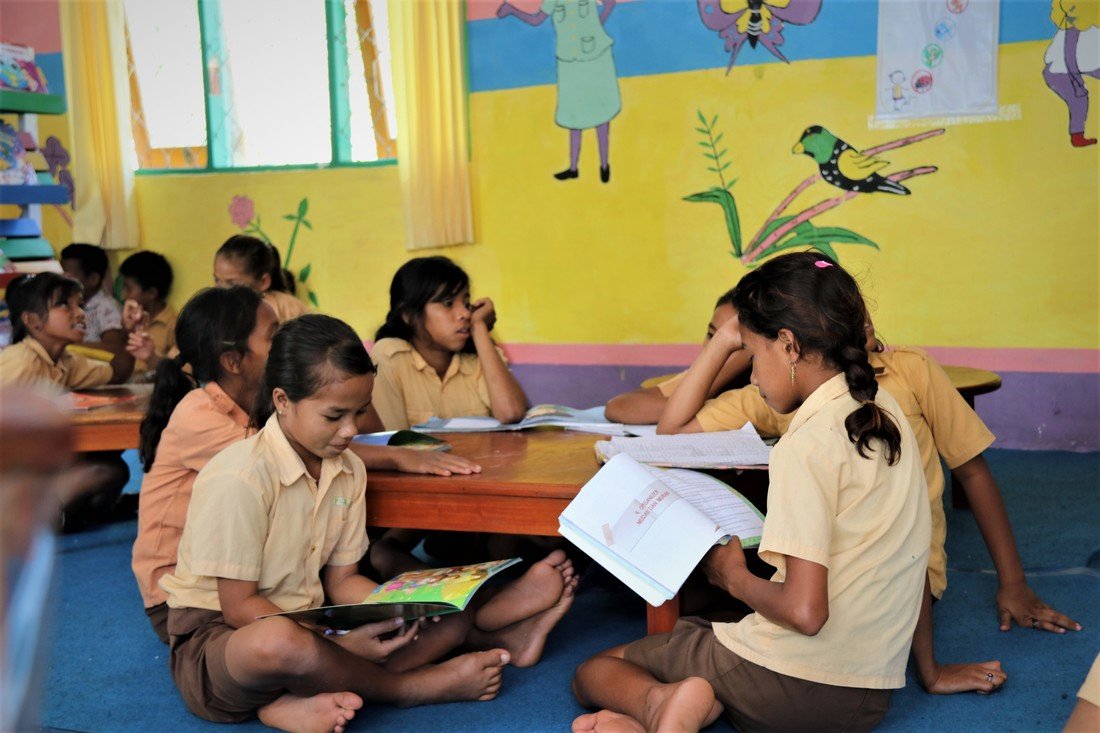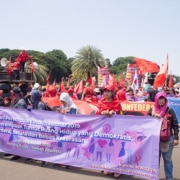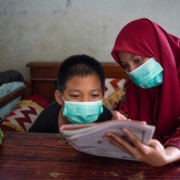
In one recent study, female students reported more interest in learning than male students. Photo by Inovasi, and was taken with consent.
Over the last few decades, Indonesia has taken great strides to expand access to education. Official data shows that Indonesia has achieved near universal participation in elementary school.
Data also reveals that historical differences in access between female and male students have all but disappeared. In fact, female students now have a slightly higher participation rate compared to male students. This is a great achievement, and as the world marked International Women’s Day on 8 March, one of which Indonesia should be proud.
Internationally, academic studies have found that female elementary students tend to have better learning outcomes than their male peers. One literature review found male students in the early grades of elementary school consistently score behind girls in literacy in almost every situation.
Similar findings have been observed in the Indonesian context. A study by RTI, for example, found that, overall, the academic performance of male students was significantly lower than that of female students. However, performance gaps varied considerably based on location (urban or rural) and type of school (primary or middle school, public or religious school).
A recent study by the Innovation for Indonesia’s School Children (Inovasi) program, a partnership between the governments of Australia and Indonesia, confirmed these findings. Using basic and comprehensive literacy tests, we found that female students in the early grades performed better than male students in almost every district. Moreover, girls outperformed boys not just in literacy, but also in numeracy.
This is one of the few analyses available in Indonesia to challenge the common stereotype that boys do better with numbers than girls.
In order to understand why female students are performing better, we need to see what actually happens in the classroom, at school, and at home. In Indonesian classrooms, female students are more likely to be perceived as better behaved. One teacher in our study explained that it is easier to teach female students than male students because female students are more cooperative and engaged in classroom activities. Similarly, female students reported greater interest in learning.
Teachers’ stereotyping of boys as naughty and disruptive students can also affect their expectations of and treatment of students. Data from classroom observations reveals that teachers interact more with female students than male students. The fact that teachers praise female students’ behaviour and interact with them more frequently may be important contributors to why female students report more interest in learning than males.
Moreover, data also found that female students reported being bullied less frequently than male students. It is little wonder that female students are more enthusiastic about school if they are being bullied less.
These broad findings about female students’ stronger interest in learning were confirmed by a school library pilot project Inovasi conducted in Sumba. In almost every school visited, borrowing records showed that female students borrowed books much more often than male students. A librarian we interviewed said that during break periods, male students tended to play outside while female students were more likely to visit the library.
Other sociocultural and economic factors may help to explain the gender gap in education outcomes. The Inovasi program is being implemented in poorer areas of Indonesia where both boys and girls are often expected to help parents to meet their economic needs. Girls are more likely to be asked to perform domestic work, while boys more often work in the field or out of the home in activities such as farming or fishing. This means male students are at greater risk of skipping school and may have less time to study at home after school.
Despite these strong results at the elementary level, female students’ participation is still at significant risk at the high school level, particularly in remote areas. As noted, across the country as a whole, Indonesia has now achieved gender parity in education participation. But in two of the Inovasi program’s partner districts, Probolinggo and Sumba Tengah, male students’ participation rates return to being higher than female students at the senior high school level.
There are a range of reasons that may contribute to this, including gender stereotyping and poverty, which can result in education of males being prioritised over females. But one factor that is likely to be playing a role in these districts is child marriage. Rates of child marriage are high in many districts of East Java. In Probolinggo, for example, prevalence of child marriage is a shocking 41 per cent. Meanwhile in Sumenep, Pasuruan, Batu City, and Sidoarjo, prevalence is 34 per cent, 24 per cent, 17 per cent and 7 per cent, respectively. The prevalence of child marriage in East Nusa Tenggara is also reportedly more than 20 per cent.
Child marriage can of course have impacts on male students too. But the phenomenon usually affects female students earlier. Although there are no formal regulations preventing married female students from going to school, many female students who marry before they are 18 are encouraged to drop out of school, especially if they become pregnant. They then have fewer opportunities to return.
In 2019, the national legislature revised the 1974 Marriage Law to bring the marriageable age for girls in to line with that for boys, which is 19. It is hoped that this policy will not just prevent more girls from child marriage, but also give every child, especially female students, more chances to pursue education throughout high school and beyond.
As our study demonstrated, even in low-resource areas, female students want to learn, and they outperform their male peers, if they are given the opportunity.
Inovasi is a partnership between the governments of Australia and Indonesia, managed by Palladium. Working directly with Indonesia’s Ministry of Education and Culture, Inovasi is seeking to understand how student learning outcomes in literacy and numeracy can be improved in diverse primary schools and districts across Indonesia.








